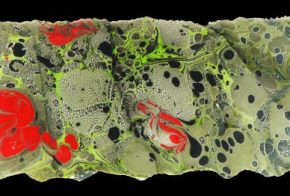The Suminagashi works by Japanese artist Ryosaku Kotaka combine ancient Chinese and Japanese painting philosophy with imaginative contemporary. Suminagashi, (pronounced, ‘sue-me-NAH-gah-she’) is the name given to the ancient Japanese technique of decorating paper with ink.
Suminagashi is a technique which was practiced in Japan as early as the 12th century and literally translated means ‘ink-floating,’. The process is as follows: ink is carefully dropped on to still water and blown across the surface to create delicate patterns. Once finished, paper is lowered onto the water’s surface and absorbs the ink.
Kotaka produces his work upon ‘Washi’ (Japanese paper) made by himself. By beginning with collecting Kozo, (Mulberry wood), stripping and draining its fibers, to drying and pressing them, he produces a thin tissue paper able to accurately absorb ink from the water’s surface .
Not so clearly seen as in his other works, this painting seeks to capture the image of water and it’s behaviour. Kotaka has used the ink to highlight the appearance of water rather than use water and ink as tool for specifically developing abstract designs.
Back
